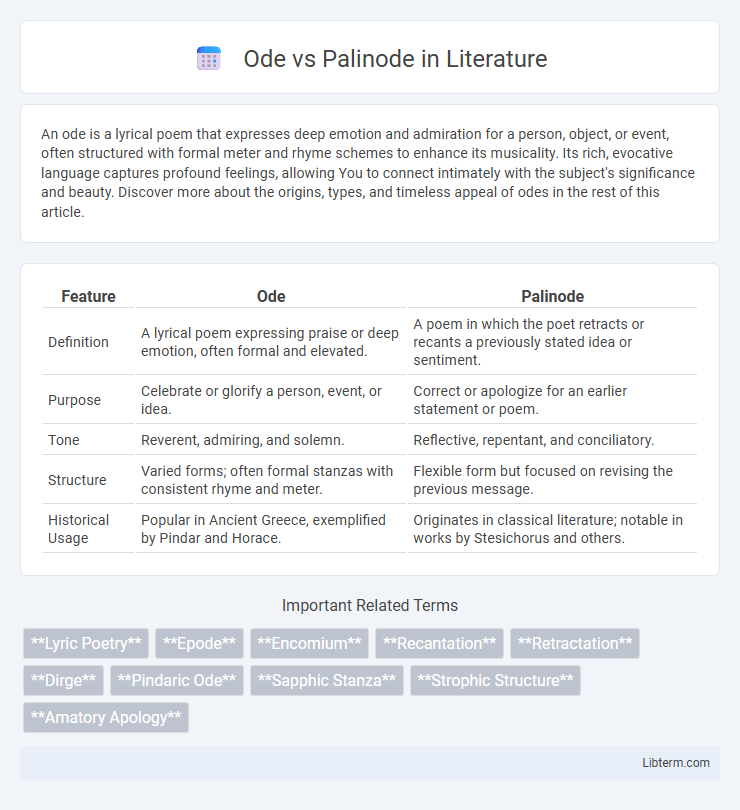An ode is a lyrical poem that expresses deep emotion and admiration for a person, object, or event, often structured with formal meter and rhyme schemes to enhance its musicality. Its rich, evocative language captures profound feelings, allowing You to connect intimately with the subject's significance and beauty. Discover more about the origins, types, and timeless appeal of odes in the rest of this article.
Table of Comparison
| Feature | Ode | Palinode |
|---|---|---|
| Definition | A lyrical poem expressing praise or deep emotion, often formal and elevated. | A poem in which the poet retracts or recants a previously stated idea or sentiment. |
| Purpose | Celebrate or glorify a person, event, or idea. | Correct or apologize for an earlier statement or poem. |
| Tone | Reverent, admiring, and solemn. | Reflective, repentant, and conciliatory. |
| Structure | Varied forms; often formal stanzas with consistent rhyme and meter. | Flexible form but focused on revising the previous message. |
| Historical Usage | Popular in Ancient Greece, exemplified by Pindar and Horace. | Originates in classical literature; notable in works by Stesichorus and others. |
Introduction to Ode and Palinode
An ode is a lyrical poem characterized by its formal tone, elaborate structure, and expression of deep emotion or praise, often dedicated to a specific subject or theme. A palinode is a poetic form in which the poet retracts or recants a statement made in an earlier poem, effectively reversing a previously expressed idea. Both forms highlight the dynamic nature of poetic expression, with odes emphasizing admiration and palinodes showcasing poetic self-correction or reconsideration.
Definition and Origins of Ode
An ode is a lyrical poem characterized by its formal tone, expressive style, and elaborate structure, originating in ancient Greece as a tribute to gods or heroic deeds. It typically consists of stanzas with a regular rhyme scheme and meter, crafted to evoke deep emotion and admiration. In contrast, a palinode is a poem in which the poet retracts a view or statement made in an earlier work.
Definition and Origins of Palinode
A palinode is a poetic form in which the author retracts a statement made in an earlier poem, typically expressing regret or correction, distinguishing it from an ode, which is a lyrical poem praising a subject. The origin of the palinode traces back to classical Greek literature, notably attributed to Stesichorus, who composed a famous palinode to retract a defamatory poem. This form emphasizes self-correction and reflection, often serving as a poetic apology or clarification within literary traditions.
Key Differences Between Ode and Palinode
An ode is a lyrical poem expressing praise or strong emotion toward a subject, often structured with formal meter and elevated language, while a palinode is a poetic form in which the author retracts a statement made in an earlier poem or expresses regret. Odes typically celebrate themes such as beauty, nature, or heroic deeds, whereas palinodes center on correction and apology, serving as a literary reversal. The key difference lies in intent: the ode's purpose is to glorify, whereas the palinode aims to amend or recant previous assertions.
Structural Elements of Odes
Odes typically feature a structured format comprising stanzas with a fixed meter and rhyme scheme, often arranged in three parts: the strophe, antistrophe, and epode, which create a musical and balanced rhythm. In contrast, a palinode reverses or retracts a previous statement, generally adopting a simpler, more direct structure without the intricate stanzaic organization found in odes. The structural complexity of odes enhances their lyrical and formal qualities, distinguishing them from the straightforward, corrective nature of palinodes.
Structural Elements of Palinodes
Palinodes feature a unique structural element where the poet retracts or recants statements made in a previous poem, often mirroring the original's meter and rhyme scheme for direct contrast. These compositions typically consist of a series of stanzas maintaining the same form as the preceding ode, emphasizing revision through repetition and inversion of themes. The structural interplay between the original ode and the palinode creates a dynamic poetic dialogue that highlights both consistency and contradiction within the work.
Themes Explored in Odes
Odes primarily explore themes of reverence, admiration, and celebration, often addressing subjects such as nature, love, heroism, or personal reflection. They emphasize emotional intensity and lyrical praise, creating an elevated tone that honors their focus. Unlike palinodes, which retract previous statements, odes maintain a consistent, laudatory perspective throughout the poem.
Themes Explored in Palinodes
Palinodes often explore themes of repentance, retraction, and the reconsideration of previously expressed beliefs, highlighting the poet's evolving perspective. These poems emphasize the mutable nature of truth, self-reflection, and the human capacity for change, contrasting with the celebratory or reflective tone typically found in odes. The thematic focus on apology and correction in palinodes provides a nuanced exploration of personal growth and intellectual humility in poetic form.
Famous Examples of Odes and Palinodes
Famous examples of odes include John Keats' "Ode to a Nightingale" and Pindar's "Olympian Odes," both celebrated for their lyrical praise and rich imagery. In contrast, notable palinodes like Stesichorus' poem retracting slanders against Helen of Troy demonstrate a poetic reversal or retraction of previous statements. These works illustrate the distinct purposes of odes in glorification and palinodes in correction within classical literature.
Impact and Relevance in Modern Poetry
Odes remain a powerful poetic form that celebrates people, events, or ideas with elevated language and structured stanzas, significantly influencing modern poetry through their capacity for emotional expression and thematic depth. In contrast, palinodes, which involve retracting or recanting earlier statements, contribute to modern poetry by fostering introspection and complex narrative layers, allowing poets to explore themes of doubt and transformation. Both forms maintain relevance as tools for conveying nuanced human experiences, impacting contemporary poetic innovation and reader engagement.
Ode Infographic

 libterm.com
libterm.com